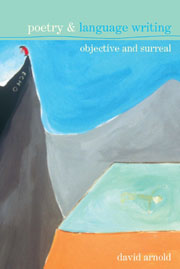Book contents
- Frontmatter
- Contents
- Acknowledgements
- List of permissions
- 1 The Scholarly Life of Language Writing
- 2 Surrealism: An Excommunicated Vessel?
- 3 Under the Sign of Negation: William Carlos Williams and Surrealism
- 4 The Surreal-O-bjectivist Nexus
- 5 Michael Palmer's Poetics of Witness
- 6 Scorch and Scan: The Writing of Susan Howe
- 7 ‘Just Rehashed Surrealism’? The Writing of Barrett Watten
- Notes
- Bibliography
- Index
6 - Scorch and Scan: The Writing of Susan Howe
- Frontmatter
- Contents
- Acknowledgements
- List of permissions
- 1 The Scholarly Life of Language Writing
- 2 Surrealism: An Excommunicated Vessel?
- 3 Under the Sign of Negation: William Carlos Williams and Surrealism
- 4 The Surreal-O-bjectivist Nexus
- 5 Michael Palmer's Poetics of Witness
- 6 Scorch and Scan: The Writing of Susan Howe
- 7 ‘Just Rehashed Surrealism’? The Writing of Barrett Watten
- Notes
- Bibliography
- Index
Summary
At first sight of her biography, there is little to connect Susan Howe with the themes of this study. Born in 1937, hers is not the ‘Vietnam generation’ to which many Language writers belong. As a writer, her influences derive predominantly from the textual history of America, not from the experiments of the European avant-garde. She is fascinated with the Puritan testimonies of seventeenth-century New England and with their persistence in the American literary tradition. Emily Dickinson is a key figure in this respect, as are Herman Melville and Henry David Thoreau. Not that the textual history of America includes only texts written in America. Howe's Emily Dickinson corresponds with Emily Brontë, Elizabeth Barrett Browning, Robert Browning and Charles Dickens. Shakespeare is also a recurrent point of reference for her. Her maternal roots in Ireland have helped to shape her interest in the history and literature of that island. Language writing is sometimes described in terms of its resistance to, or exile from, the academy. This description fits Howe in a singular way. In a literal sense, she was very close to the institution of scholarship. Her father taught constitutional law and legal history at Harvard, where both F. O. Matthiessen and Perry Miller were friends of the family.
- Type
- Chapter
- Information
- Poetry and Language WritingObjective and Surreal, pp. 112 - 137Publisher: Liverpool University PressPrint publication year: 2007



